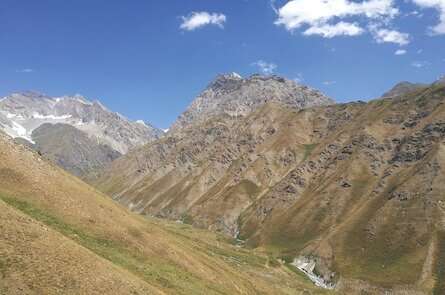Rainy season tends to begin earlier in Northern Central Asia

Researchers from the Institute of Atmospheric Physics (IAP) of the Chinese Academy of Science (CAS) found that the rainy season of northern Central Asia, which occurs in May-July in present-day, will shift to March-May at the end of the 21st century. The study was published in Environmental Research Letters.
Central Asia is characterized by scarce precipitation and high evaporation. People's livelihoods and the fragile ecosystem are highly sensitive to changes in local precipitation.
"This region is one of the hot spots of global warming, where a stronger than global mean warming trend is projected in the coming century. But the future precipitation changes are less clear," said Jie Jiang from IAP, the paper's first author. "Besides the amount of precipitation, the changes in the phase of precipitation also affect agriculture and other fields."
To give a comprehensive picture of the future changes in precipitation over Central Asia, the researchers adopted the multimodel simulations and projections of 15 models from the new phase of the Coupled Model Intercomparison Project (CMIP6).
They also used projections under four combined scenarios of the Shared Socioeconomic Pathways and the Representative Concentration Pathways (SSP1-2.6, SSP2-4.5, SSP3-7.0 and SSP5-8.5). These scenarios reflected a set of alternative futures of social development and greenhouse gas emission.
The researchers found robust increase of annual mean precipitation at the end of the 21st century under all scenarios. The increasing rate was about 14.41% for the highest emission scenario (SSP5-8.5) and near 4.23% for the lowest emission scenario (SSP1-2.6) relative to present-day. The model spread was larger for higher emission scenarios, which could be partly attributed to the larger uncertainty of the surface air temperature.
Further analysis revealed a wetting trend in spring and a drying trend in summer, which would result in enhanced seasonality of precipitation over Central Asia and a shift of the rainy season in the northern Central Asia. The increase of precipitation in spring was balanced by increasing evaporation, while the decrease in summer was mainly due to the changes in vertical moisture advection.
"Central Asia is dominated by descending motion and low-level divergence in summer. The increase of atmospheric water vapor due to rapid warming can result in the decrease of vertical moisture advection and contributes to the drying trend in summer, which is the so-call dry-getting-drier mechanism," Jiang explained. "In addition, the changes in the location and strength of subtropical westerly jet due to anthropogenic activity can also affect the annual cycle of precipitation."
The researcher also discussed the changes in drought condition over this drought-prone region. Based on the Surface Wetness Index (SWI), they found drought might become even more severe in the coming century though increasing precipitation was projected. "Adaptation measures for future climate changes should consider both the shift of rainy season and increased aridity over this region," Jiang said.
More information: Jie Jiang et al, Future changes in precipitation over Central Asia based on CMIP6 projections, Environmental Research Letters (2020). DOI: 10.1088/1748-9326/ab7d03
Journal information: Environmental Research Letters
Provided by Chinese Academy of Sciences




















